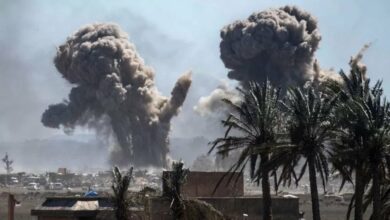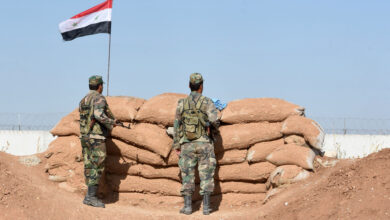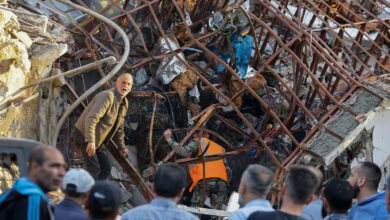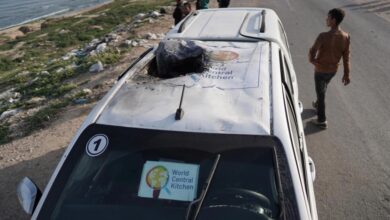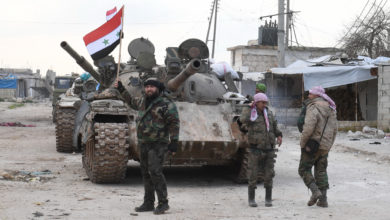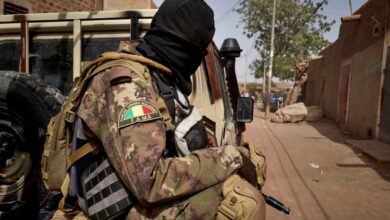An education in Islamic State extremism
In its proto-state, Islamic State focused on education to indoctrinate children through textbooks that glorified violence
The so-called Caliphate has been territorially defeated, but Islamic State has left behind a dangerous legacy. Thousands of children are stuck in camps in Iraq and Syria, while some children of foreign parents have been able to return to their home countries. ISIS spent years indoctrinating them, including through a form of formal schooling. Textbooks used by ISIS show one part of its efforts to corrupt a new generation with its extremist ideology.
Islamic State had long harbored goals of becoming more than an insurgent group. Military victories through 2013 and 2014 saw it sweep across Iraq and Syria, capturing territory the size of Great Britain, and giving it the resources and population needed to start building a proto-state.
Among its state-like endeavours was a formal education system.
ISIS saw education as an important tool to help further its goals, and schooling was exploited to indoctrinate an entire generation living under their control. ISIS also believed it had to rectify what it viewed as “improper” education systems that preceded it in Iraq and Syria.
Among the administrative creations set up in the early days of the proto-state was the Diwan al-Ta’aleem, a Ministry of Education, and internal ISIS documents show the importance the group placed upon educating children. In a text that sets out the principles of administration in their territory, one chapter is dedicated to schooling, with the opening line stating that “Education is the foundation upon which Islamic society is built.” Other documents also show ISIS believed that education had been used as a tool to corrupt children to suit the needs of the Iraqi and Syrian governments, teaching un-Islamic ideas and concepts.
ISIS decided to implement an entirely new syllabus with its own teaching materials, but this was not a simple process. A deadline of late 2015 was set to instigate the new education program. Schooling continued ahead of that change, but the previous system was modified: subjects such as art and music were cut, while existing textbooks were altered to bring them in line with the group’s views.
Like many of its state-building efforts, ISIS built on what already existed. It was impossible for the group to recruit and train new teachers with the time and resources it had, so alongside recruiting some new teachers, ISIS kept many who already lived in its territory but required them to carry out ‘repentance’ sessions and ‘sharia’ classes.
In late 2015, schools started the new curriculum using textbooks specially produced by the group. Attendance was compulsory from the age of five to 15, and classes were segregated by gender. Despite the risk of punishment, many parents tried to avoid sending their children to school, fearing the danger to their children.
English was among the subjects taught, beginning in the fourth school year, and the textbooks that teachers were required to use provide a snapshot of one way ISIS tried to indoctrinate children.
Immediately apparent is the normalization of violence.

The very first set of English vocabulary children learned included the words “army,” “bomb,” and “bullet.” Other vocabulary introduced later included gun, battle, pistol, sniper, martyr, mortar, tank, military, weapons, war, and bazooka.

The cover of “English for the Islamic State, Book 3” features a young child with a gun slung across his back. Throughout the book there are images of violence and conflict, with illustrations of weapons, as well as photographs of fighters and weapons, occasionally in active combat, for students to learn the vocabulary. Illustrations of guns are used as decoration in the corners of many pages.

ISIS fighters are depicted positively, often featured in example texts and described with positive words. Activities are often based around violent concepts: connect-the-dots would see students draw guns and tanks, while when teaching prepositions, words like gun and bazooka were used.

As well as normalizing violence, education was used to legitimize ISIS and their so-called state. Some of the earliest directives by Diwan al-Ta’aleem were to remove any references to the Iraqi or Syrian governments, replacing them with ‘Islamic State.’ This continued in ISIS-produced textbooks with it being mentioned repeatedly in positive way and described as if it was a functioning, official state.

Pictures of the group’s flag are common throughout the textbooks. It is used to teach the colors black and white, and often features in the example images and texts that exercises are based around. An entire section of the third English textbook is even dedicated to the flag, often referred to as “our Islamic flag.”

Themes common in ISIS propaganda can be seen replicated within these textbooks. One common form of the group’s messaging is so-called ‘victimhood’ propaganda in which Sunni Muslims are portrayed as facing overwhelming persecution. This theme allows ISIS to attempt to present itself as protecting its people, while also instilling hatred towards those who it claims are responsible for oppression. Elements of this can be seen in a series of exercises based around an example text about how a building was bombed by a Syrian regime plane, describing in detail how those inside had all been killed.
Another theme that is used in the textbooks is the concept of ‘utopian’ propaganda, where ISIS presents everyday life in the caliphate as the Islamic ideal. This is widely seen in textbooks, with life in ISIS territory portrayed positively compared to other locations.
Like many ISIS state-building efforts, reality was not the same as presented in the books. The group often struggled to fully realize aspects of the state they desired. Education was no different: many children did not go to school, some schools remain closed, and many were forced to fight as child soldiers.
Education was only one of many methods that ISIS used to indoctrinate children.
At media points set up throughout their territory, ISIS would entice children with free food and drinks, encouraging them to watch propaganda videos. Children were also exploited in such videos; in the most extreme cases ISIS made children carry out executions or participate in combat that was filmed and later broadcast in cities and through social media.
ISIS also coerced children to join the ‘cubs of the caliphate training regimes. This become more important as the group came under increasing military pressure and needed as many fighters as possible, and state-like functions such as education became less essential compared to defending territory. Many children, especially Yazidi boys, were kidnapped and forced to fight.

With the military defeat of the territorial caliphate, ISIS remains a dangerous insurgency. If it gets the opportunity, the group may try to regain the territory it once occupied in Iraq and Syria and re-implement the education system it believed so important. One of the many ISIS branches operating around the world could also attempt to hold territory and implement a similar education system, or do so within their own camps.
ISIS textbooks have also been disseminated online. Download links have appeared on messenger sites like Telegram – which is popular with ISIS and its supporters – and mainstream social media sites such as Facebook, which claims more than one billion monthly active users. Counters on sites where textbooks can be obtained show many have been downloaded tens of thousands of times.
More pressing is the need to deal with the fallout of ISIS’s indoctrination of children. While territory in Iraq and Syria has been lost, many children are not truly freed from its grasp, and remain victims of indoctrination, and authorities in Iraq and Syria now face the difficulty of dealing with the children who learned from these texts or been indoctrinated in other ways. Worsening the problem, many countries have been reluctant to repatriate the children of their nationals who joined ISIS.
Almost 5,000 children were taken to Iraq and Syria by parents who joined ISIS and more were born there. As ISIS lost its last territory in Syria, tens of thousands of men, women and children surrendered and were placed in tent camps. The al-Hol camp in northern Syria is home to more than 70,000 people, 70% of them are children. In Iraq it is harder to get a clear picture on the number of children, but more than 1,000 are in the Iraqi justice system, either accompanying their mothers or facing trial themselves. Some children have reportedly faced torture.
While no longer carrying out indoctrination on a state-wide scale, for the thousands of children that were exposed to the indoctrination of ISIS the situation is not over. Those who escaped ISIS must now be helped to reintegrate into a society that they were taught to hate.



